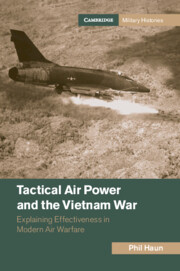Book contents
- Tactical Air Power and the Vietnam War
- Cambridge Military Histories
- Tactical Air Power and the Vietnam War
- Copyright page
- Dedication
- Contents
- Figures
- Maps
- Tables
- Preface
- Abbreviations
- 1 Introduction
- 2 Tactical Air Power Theory
- 3 Vietnam and Rolling Thunder: 1965–1966
- 4 Khe Sanh and Tet: 1967–1968
- 5 Commando Hunt I–III and Cambodia: 1969–1970
- 6 Commando Hunt V–VII and Lam Son 719: 1971–1972
- 7 Easter Offensive and Linebacker I & II: 1972–1973
- 8 Analysis and Conclusion
- 9 Epilogue
- Book part
- Index
2 - Tactical Air Power Theory
Published online by Cambridge University Press: 04 January 2024
- Tactical Air Power and the Vietnam War
- Cambridge Military Histories
- Tactical Air Power and the Vietnam War
- Copyright page
- Dedication
- Contents
- Figures
- Maps
- Tables
- Preface
- Abbreviations
- 1 Introduction
- 2 Tactical Air Power Theory
- 3 Vietnam and Rolling Thunder: 1965–1966
- 4 Khe Sanh and Tet: 1967–1968
- 5 Commando Hunt I–III and Cambodia: 1969–1970
- 6 Commando Hunt V–VII and Lam Son 719: 1971–1972
- 7 Easter Offensive and Linebacker I & II: 1972–1973
- 8 Analysis and Conclusion
- 9 Epilogue
- Book part
- Index
Summary
Chapter 2 provides a historical account of the development of tactical air power during the interwar period and World War II in Germany, the Soviet Union, Great Britain, and the United States. Air and ground force coordination has largely been ignored in peacetime, and only in combat has a sense of urgency arisen for developing and refining joint doctrine. Even then, the focus has been on defining air and ground command relationships and improving the coordination between an air force’s tactical air control systems (TACS) and the army’s air–ground systems (AAGS). These doctrinal efforts increased the efficiency of allocating and controlling air power to support ground operations. However, largely left unspoken and unwritten has been an understanding of why, how, and when tactical air power works. TAP theory answers these questions by asserting that air power’s asymmetric advantage is its ability to locate and attack massed and maneuvering armies. With air superiority secured, lethal air-to-ground forces threaten armies, causing them to disperse and hide. The enemy’s reaction, in turn, provides friendly ground forces an advantage in conducting both offensive and defensive operations. Unfortunately, a theory explaining the primary impact of air power in modern warfare has been absent until now.
Keywords
- Type
- Chapter
- Information
- Tactical Air Power and the Vietnam WarExplaining Effectiveness in Modern Air Warfare, pp. 13 - 34Publisher: Cambridge University PressPrint publication year: 2024

